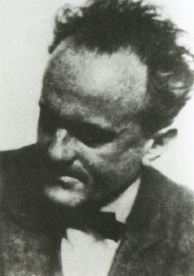
Paul Kammerer
If a person acquires a limp during their lifetime, can that limp be passed on to their children? Or if a person acquires a scar, will that scar be hereditary? Modern scientific theory denies this is possible, but a theory called Lamarckianism held that not only was it possible, but it was the means by which evolutionary change occurred.
During the 1920s, Austrian scientist Paul Kammerer designed an experiment involving a species called the Midwife Toad to prove that Lamarckian inheritance was possible.
Most toads mate in water. As a result they have black, scaly bumps on their hindlimbs that help them hang onto each other while they mate. The Midwife Toad, by contrast, mates on land and lacks these bumps. Kammerer wanted to demonstrate that if the Midwife Toad was forced to mate in water, it would eventually acquire the same bumps that naturally water-mating toads possessed — and that the toad's offspring would inherit these bumps via Lamarckian inheritance.
Kammerer filled a fishtank full of water, placed some Midwife Toads in it, and then waited as generations of toads were born and died. Finally he announced success. A generation of Midwife Toads had been born with black scaly marks on their hindlimbs. This appeared to prove that Lamarckian inheritance was possible.
The scientific community was stunned. If true, Kammerer's results would have turned the entire edifice of evolutionary theory on its head, forcing scientists to reevaluate everything they knew about the process of inheritance.
However, when Dr. G.K. Noble, Curator of Reptiles at the American Museum of Natural History, examined Kammerer's famous toads, he discovered that the toads didn't actually possess black, scaly marks on their hindlimbs. Instead, they displayed subcutaneous inkspots where someone had injected black ink beneath the surface of their skin.
When the fraud was unveiled in 1926, Kammerer was humiliated. He insisted he hadn't injected ink into the toads and suggested one of his lab assistants might have done it.
Whoever might have committed the fraud, it was Kammerer that bore the fallout from it. His reputation was ruined. A few days later he committed suicide. With him went the case for Lamarckian inheritance.
Links and References
- Koestler, Arthur. (1971). The Case of the Midwife Toad. Random House.


Comments
I also suggest you read this article from a reputable site;
http://www.the-scientist.com/?articles.view/articleNo/32637/title/Lamarck-and-the-Missing-Lnc/
thank you